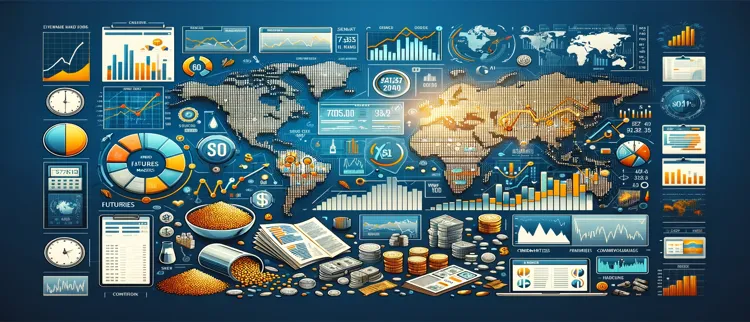In the financial markets, futures trading offers a dynamic platform where commodities, currencies, and indices are bought and sold based on predictions of future prices. These predictions are heavily influenced by economic indicators—data points that provide insights into an economy’s health. Understanding the interplay between economic indicators and futures markets is crucial for traders, especially in online trading, where decisions need to be quick and based on accurate, up-to-date information.
This blog post explores the critical economic indicators influencing futures markets and how traders can leverage this information to enhance their trading strategies. Understanding these indicators can provide a significant edge in navigating this volatile environment, whether you are a seasoned trader or new to the futures market.
Section 1: Understanding Economic Indicators
Economic indicators are statistics that convey certain economic conditions over a specific period. These indicators are usually compiled and published by government agencies or private economic organizations and are used to analyze economic performance and predict future trends. They can be classified into three main types:
- Leading Indicators are predictive in nature, providing early signals about the direction of the economy. Examples include stock market returns, housing permits, and the index of consumer expectations.
- Lagging indicators confirm long-term trends and are only apparent after economic activity has occurred. Unemployment rates and corporate profits are typical examples.
- Coincident Indicators: These change simultaneously as the economy and include GDP, retail sales, and personal income.
Understanding these indicators is foundational in forecasting economic performance. For traders in future markets, these indicators can signal potential changes in market conditions, influencing strategies in commodity, currency, and index futures.
Section 2: Economic Indicators and Futures Markets
Economic indicators play a pivotal role in shaping the futures markets. These indicators provide a snapshot of the current economic condition and offer forecasts that help traders anticipate market movements. Understanding the specific relationship between these indicators and various types of futures can significantly enhance trading strategies.
Influence on Commodity Futures
Commodity futures, which include energy resources like oil and agricultural products like wheat, are highly sensitive to economic indicators:
- Supply and Demand Data: Indicators that provide insights into supply and demand, such as inventory levels and production forecasts, directly influence commodity prices. For example, a report showing a significant increase in crude oil inventories usually leads to decreased oil prices due to perceived oversupply.
- Economic Growth Indicators: Strong economic growth often leads to higher commodity demand as industries expand and consumption increases. GDP growth rates can, therefore, be a bullish signal for commodity traders.
Impact on Currency Futures
Currency futures are another major segment of the futures market affected by economic indicators:
- Interest Rate Decisions: Currency traders closely monitor central bank policies and interest rate decisions. For instance, if the Federal Reserve announces an interest rate increase, the dollar typically strengthens, affecting USD futures.
- Economic Health Indicators: Employment rates and manufacturing data can indicate the health of an economy and influence currency valuation. High unemployment rates might weaken a currency, impacting related futures contracts.
Effects on Index Futures
Index futures, representing baskets of stocks like the S&P 500 or the Dow Jones Industrial Average, are influenced by broader economic indicators:
- Consumer Confidence and Spending: High consumer confidence and spending can drive up stock prices, positively impacting index futures.
- Corporate Earnings and Profitability: Earnings forecasts and profitability reports can cause significant swings in index futures as they directly affect the valuations of the companies in the index.
Predictive Nature of Economic Indicators
Certain economic indicators are particularly valued for their predictive nature. For example:
- Leading Indicators: Indicators like the Purchasing Managers’ Index (PMI) and housing starts can provide early signals about the future economic direction, which is crucial for futures traders who need to anticipate market movements.
- Global Economic Indicators: In an interconnected global economy, international economic indicators such as China’s manufacturing data or Europe’s GDP growth also impact U.S. futures markets by influencing global economic sentiment.
Strategic Use in Online Trading
Traders involved in online trading must be especially adept at interpreting and integrating these indicators into their trading strategies. Platforms that offer advanced charting tools and real-time data feeds help traders visualize how economic announcements influence market movements and adjust their positions accordingly.
By continuously monitoring these indicators, traders can position themselves to respond swiftly to market changes, capitalizing on opportunities presented by economic developments. This proactive approach is essential in the fast-paced environment of futures trading, where market conditions can shift dramatically with each new economic report.
Section 3: Key Economic Indicators to Watch and Their Impact on Futures Markets
Understanding which economic indicators have the most substantial influence on futures markets can give traders a significant advantage. Here, we explore several critical indicators affecting various futures contracts and how this knowledge can be leveraged in online trading.
Gross Domestic Product (GDP)
GDP is the broadest indicator of economic activity and provides a comprehensive snapshot of a country’s economic health. It has a profound impact on nearly all futures markets:
- Commodities: Strong GDP growth suggests high demand for commodities, driving up prices for futures in oil, metals, and agriculture.
- Currency: Robust GDP growth can strengthen a nation’s currency, impacting currency futures by increasing demand for the currency relative to others.
- Indices: Positive GDP reports often boost investor confidence and lead to bullish stock index futures trends.
Unemployment Rate
The unemployment rate is a key indicator of economic stability and consumer spending capability:
- Currency Futures: High unemployment rates can weaken a currency, as they may prompt central banks to introduce stimulus measures or cut interest rates.
- Index Futures: High unemployment can lead to declines in index futures, as it reflects potential downturns in economic health and corporate profitability.
Consumer Price Index (CPI)
CPI measures inflation and is closely watched by futures traders for its direct impact on purchasing power and interest rate movements:
- Commodity Futures: Inflation typically increases the cost of goods, directly affecting commodity prices. For example, rising inflation could lead to higher prices for gold, often seen as an inflation hedge.
- Currency Futures: Higher inflation may weaken a currency unless countered by rising interest rates. Traders use CPI data to predict central bank actions, which can influence currency futures.
Consumer Confidence Index
Consumer confidence is an indicator of the financial health of an economy’s consumers, affecting their spending and investment behaviours:
- Index Futures: High consumer confidence boosts retail sales and expenditures, supporting bullish sentiment in equity markets.
- Commodity Futures: Increased consumer confidence can lead to higher energy and consumer goods demand, driving up relevant commodity futures.
Global Economic Indicators
In today’s interconnected global economy, international economic reports can also have a significant impact on domestic futures markets:
- Chinese Manufacturing Data: As a major global economic player, China’s manufacturing output can influence commodity futures worldwide, particularly metals and energy products.
- Eurozone GDP and Unemployment: These indicators affect global market sentiment and can impact U.S. index and currency futures.
Leveraging Economic Indicators in Online Trading
For those engaged in online trading, staying ahead of these economic indicators is crucial. Many online trading platforms offer tools like economic calendars, real-time alerts, and advanced analytics to help traders make informed decisions. Understanding the timing and potential impact of these indicators allows traders to position themselves advantageously before major announcements, managing risk and capitalizing on market volatility.
Section 4: Using Economic Indicators in Online Trading Strategies
For traders in the futures markets, having a strategy that incorporates economic indicators can significantly enhance the ability to predict market movements and manage risk. Here are several practical approaches for integrating this data into online trading activities:
Utilize Economic Calendars
Stay Ahead of the Curve:
- Preparation: Use online trading platforms that feature comprehensive economic calendars. These tools list upcoming economic releases and usually rate their potential impact on markets.
- Strategy: Plan trades around these releases. For example, if a major GDP update is coming, consider the historical impact of such data on your trading instruments and set up positions accordingly.
Real-Time Data and Alerts
React Quickly to Market Changes:
- Setup Alerts: Configure alerts for immediate updates on economic indicators that matter most to your trading portfolio.
- Speed of Execution: Ensure that the trading platform you use can execute trades quickly. Rapid reaction to news is crucial, especially when trading on information like CPI or employment figures that can cause immediate market volatility.
Sentiment Analysis Tools
Gauge Market Sentiment:
- Tools: Use tools that assess market sentiment, often derived from news feeds and social media, to understand how other traders might react to forthcoming economic news.
- Integrate Sentiment: Combine this sentiment analysis with your economic indicators to gauge whether market reaction might be bullish or bearish.
Technical Analysis Synergy
Combine Economic Indicators with Technical Tools:
- Overlay Strategies: Use technical analysis tools like moving averages, trend lines, and oscillators to identify potential entry and exit points based on economic indicators.
- Confirmatory Signals: Let economic data confirm the signals you get from technical analysis. For instance, if technical analysis suggests a bullish trend and upcoming economic data is expected to be positive, it might be a good signal to go long.
Risk Management Techniques
Protect Your Investments:
- Stop-Loss Orders: Place stop-loss orders to automatically close positions if the market moves against you after an economic announcement.
- Position Sizing: Adjust your positions’ size based on the expected volatility with an economic release. Higher volatility might warrant smaller positions to mitigate risk.
Continuous Learning and Adaptation
Stay Informed and Adapt:
- Educational Resources: Use online platforms that offer educational resources about economic indicators and their market impacts.
- Backtesting: Some platforms allow for backtesting strategies against historical data, which can be invaluable for understanding how different economic indicators might influence market conditions.
Leverage Community Insights
Learn from Others:
- Forums and Discussion Boards: Engage with other platform traders to share insights and strategies about trading on economic data.
- Webinars and Workshops: Participate in online sessions focusing on real-time market analysis, often available through trading platforms.
By incorporating these strategies, traders can more effectively utilize economic indicators to enhance their trading decisions in future markets. This approach not only aids in capitalizing on opportunities but also in navigating the complexities of market volatility driven by economic data.
Conclusion
In the fast-paced world of futures markets, understanding and utilizing economic indicators can significantly enhance a trader’s ability to make informed decisions and navigate market volatility. Throughout this blog post, we’ve explored the profound impact of various economic indicators on futures markets, from commodities and currencies to indices.
Key Takeaways:
- Importance of Economic Indicators: We’ve detailed how indicators like GDP, the unemployment rate, CPI, and consumer confidence directly influence futures prices. These metrics provide critical insights into economic health and consumer behaviour, guiding traders in forecasting market trends.
- Strategies for Integration: Employing strategies such as utilizing economic calendars, setting up real-time data alerts, and combining economic data with technical analysis tools are essential for traders looking to leverage this information effectively.
- Risk Management: We emphasized the importance of incorporating risk management techniques, like stop-loss orders and position sizing, especially when trading around high-impact economic releases.
- Continuous Learning: The dynamic nature of markets demands continuous education and adaptation. Engaging with community insights and participating in online learning resources can further enhance a trader’s expertise.
For traders and investors aiming to refine their trading strategies in online trading, mastering the application of economic indicators is indispensable. By staying informed and proactive, traders can protect their investments and capitalize on opportunities presented by market movements.
Engage with Us Further:
If you found this discussion insightful and wish to delve deeper into the intricacies of futures trading or want more advanced strategies tailored to your trading needs, consider subscribing to our newsletter. Here, you’ll gain access to exclusive content, expert analyses, and the latest updates that will help you stay ahead in the ever-evolving trading landscape. Join our community of committed traders continuously striving for excellence in the markets.
We hope this blog post serves as a valuable guide in your trading endeavours and empowers you with the knowledge to make more strategic decisions in the futures markets. Whether you are a novice or a seasoned professional, understanding economic indicators is crucial to successful online trading.






